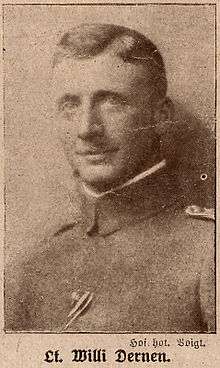Friedrich-Wilhelm Dernen

Friedrich-Wilhelm Dernen (* February 15th, 1884 in Köln - † February 15th, 1967 in Bad Homburg) was a German Oberleutnant in the Wehrmacht during World War II.
Life
Ern occurred on October 1, 1907 as a one-year volunteer in the Grenadier Regiment "Kaiser Wilhelm I." (2 Badisches) No. 110 in Mannheim one from which he was then dismissed on 30 September 1908. Reserve. With the outbreak of the First World War ern was reactivated in his tribe Regiment and as a platoon commander used. As such, he initially fought in Mulhouse , and then in the Battle of Lothingen and later in northern France in Bauvin , Vermelles and Loos . After company commander had become, he participated in the Second Battle of Artois , then in the Second Battle of Champagne and the Somme . In September 1917, he stormed at Verdun the Vaux-cross-level and end of the year he fought in the Battle of Cambrai . During the great battle in France , he led his company continues to be successful. He then entered the Aisne and Marne battle and could at Chemin des Dames prove still. After the war and march back into the home as well as the local demobilization ern was on December 6, 1918 the character as a first lieutenant of the reserve released from military service. He was active in the following years as an Administrative employee at BASF in Ludwigshafen . August 19 bis 15 September 1935 completed a ern Reserve exercise as company commander and the battalion headquarters of Infantry Regiment 26 in Flensburg . He resigned on January 1, 1936 his service as captain of the reserve and was shortly thereafter on 1 August 1936 Major promoted the Reserve. On August 27, the day of the Battle of Tannenberg ern received the character as a lieutenant colonel and was after the beginning of World War II convened on 2 September 1939 Staff of Infantry Replacement Regiment 15. Shortly afterwards, took place on October 5, 1939 he was appointed commander of the III. Battalion of Infantry Regiment 88, which was at that time for border security on the French border. Due to illness stretching was on January 29, 1940 the hospital admitted, active status in connection to the Infantry Replacement Battalion 88, and appointed on 11 April 1940 its commander. Two months later, he was appointed commander of the I. Battalion of Infantry Regiment 550 followed From 1 August to 14 October 1940, he served as head instructor of the 159th Infantry Division and was then commander of the III. Battalion of Infantry Regiment 36. This command was ern on January 17, 1942 again, was due to illness admitted to hospital and after the leaders reserve the Military District added commandos IX. After his recovery, he was on May 11, 1942 Commander of Infantry Replacement Battalion 9 and on September 27, 1942 commander of the Grenadier Regiment replacement 9. There took place on December 1, 1942 he was promoted to colonel of the reserve. Effective May 16, 1943, put him on the staff of the 90th Panzer Grenadier Division and in the following years was ern commander of Fortress Brigade Sardinia . , From August 16, 1943, he was in the leader of the Reserve OKH and was also the military commander of Belgium and Northern France ordered for incorporation as a field commander. There he was to represent the field commanders on December 7 Mont-de-Marsan commissioned. On February 8, 1944 ern was a field commander for training commander of the Army Group commanded the South of France and appointed shortly thereafter to the field commander 563. In this position he was simultaneously fighting commander of Montpellier . It commissioned ern 19 October 1944 the leadership of the 159th Infantry Division and appointed him on 1 December 1944, simultaneous promotion to major general of the reserve to their commander. Already on December 11, 1944, he handed over the command of Major General Heinrich Bürcky and he was replaced due to illness and fed the leader Reserve. Ern was January 17, 1945 appointed commander of the fortress Olomouc appointed. Due to illness he did not appear at the command and was admitted on January 25, 1945 to the hospital. After the war ern came in September 1945 in US captivity , from which he was released in February 1948.
Awards
- Iron Cross (1914) 2nd and 1st Class
- Wound Badge (1918) in Black
- Ritterkreuz I. Klasse des Ordens vom Zähringer Löwen mit Schwertern
- Ritterkreuz des Militär-Karl-Friedrich-Verdienstordens
- Ritterkreuz des Königlichen Hausordens von Hohenzollern mit Schwertern
- Pour le Mérite on 29 August 1918
- Clasp to the Iron Cross (1939) 2nd and 1st Class
- German Cross in Gold on 11 January 1942 as Oberstleutnant in the III./Infanterie-Regiment 36[1]
References
Citations
- ↑ Patzwall & Scherzer 2001, p. 82.
Bibliography
- Patzwall, Klaus D.; Scherzer, Veit (2001). Das Deutsche Kreuz 1941 – 1945 Geschichte und Inhaber Band II [The German Cross 1941 – 1945 History and Recipients Volume 2] (in German). Norderstedt, Germany: Verlag Klaus D. Patzwall. ISBN 978-3-931533-45-8.